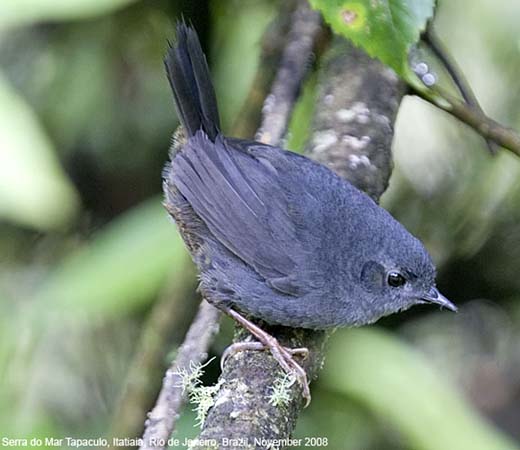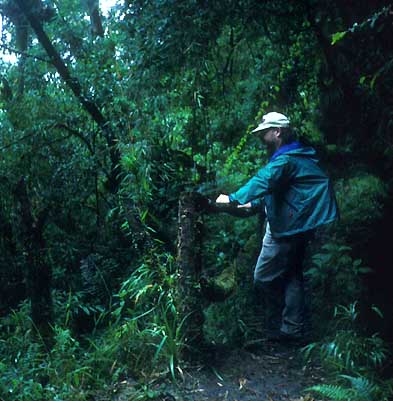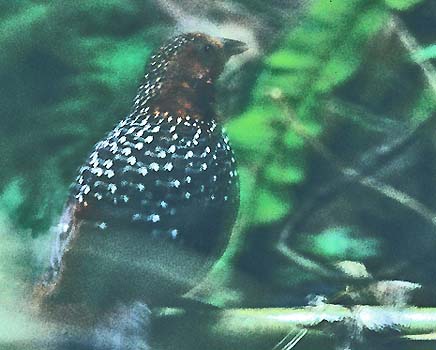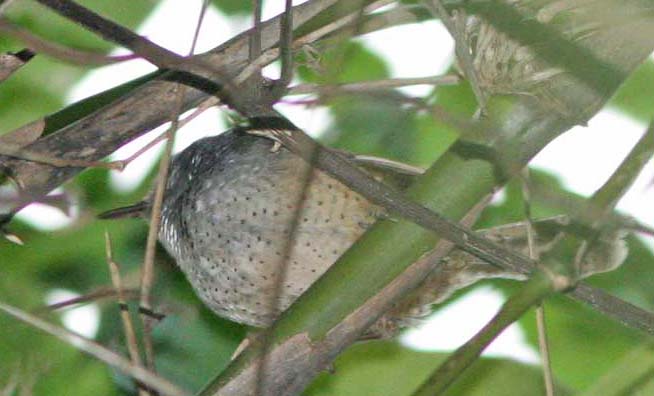| |
TAPACULOS Rhinocryptidae |
- 53 species in Neotropics
- DR personal total: 8 species (15%), 3 photo'd
|
 Tapaculos are the mice of the avian world. Restricted to the New World tropics, they scuttle in undergrowth from bamboo thickets to the dense mossy understory of remnant cloud forests. Older theories suggesting relationships with the lyre-birds or scrub-birds of Australia, but genetics has shown that the tapaculos are a distinct family whose closest relatives are the gnateaters Conopophagidae and the ground antbirds Formicariidae (Sibley & Ahlquist 1990, Krabbe & Schulenberg 2003). Tapaculos are the mice of the avian world. Restricted to the New World tropics, they scuttle in undergrowth from bamboo thickets to the dense mossy understory of remnant cloud forests. Older theories suggesting relationships with the lyre-birds or scrub-birds of Australia, but genetics has shown that the tapaculos are a distinct family whose closest relatives are the gnateaters Conopophagidae and the ground antbirds Formicariidae (Sibley & Ahlquist 1990, Krabbe & Schulenberg 2003).
They are best located and identified by their vocalizations. Well over half (37 species or ~70%) of the world's tapaculos are in the genus Scytalopus, and it seems that new species are still being described every year! I know of at least 3 more proposed species as of this writing (2010).
As example is Serro do Mar Tapaculo (left, in a great shot by Arthur Grosset). Maurício (2005) found that the otherwise relatively well known Mouse-colored Tapaculo S. speluncae actually consisted of two species, of which the southern was described as a new species (S. pachecoi) while the northern retained S. speluncae. Raposo et al. (2006) cast doubt on the nomenclature, proposing that that the tapaculo from the Serra do Mar region had to receive a new name: S. notorius ("notorius" to illustrate its problematic taxonomical history). This situation has not yet been sorted out by the SACC, but we called birds seen at Intervales State Park and Itatiaia National Park in the Atlantic mountains of Brazil "Serro do Mar Tapaculo" (and that is the one shown here in the photo taken at Itatiaia). But it does not end there. Edson Endrigo advises that the birds at Intervales sound different than those at Itatiaia — there may be even a further split down the road . . . |
 At one time there were only ten species in genus Scytalopus — now there are at least 40. Long before this current era Rita and I birded Pasachoa Park, high in the Andes of Ecuador (that's me in the rain; right). Here we ran into Brian Finch, who was "trolling" with a prerecorded tape until he got a response, and then used tape playback to get a brief but quick view of various tapaculos. We saw the large and colorful Ocellated Tapaculo here (see below) but in this same cloud forest we taped in three additional species of little tapaculos: a small brownish wren-like one with barred flanks and a hint of a whitish supercilium, a larger flat-black chunky individual giving an antshrike-like song "ho-ho-ho-ho-ho-ho-ho", and several shiny-black jobs with sloping foreheads, cocked tails and pointy bills giving a deep thrush-like "chok-chok" call. We tried to figure them out from Meyer de Schauensee (1970; very hopeless!), Hilty & Brown (1986) or Fjeldså & Krabbe (1990) but could only come up with tentative identifications [Ridgely & Tudor (1994) frankly stated that these are "probably the most complicated and difficult of all Neotropical bird genera."] The taxonomy was confused and the keys irreconcilable. After our 1992 visit tapaculo taxonomy was significantly revised by Krabbe & Schulenberg (1997; they did not even bestow English names to some of the new discoveries!). I spent hours working through it and listening to my copies of Brian's tape, but still was uncertain. It wasn't until the publication of Ridgely & Greenfield (2001) that I felt moderately confident that these three species were, respectively, Spillman's Tapaculo Scytalopus spillmanni, Ash-colored Tapaculo Myornis senilis, and Unicolored Tapaculo S. unicolor. [And these could still be wrong.] It seems next to impossible to actually see any of the little Scytalopus tapaculos unless you are using tape play-back. In my visits to South America to date, I have seen only one tapaculo without using a tape (a Northern White-crowned Tapaculo S. atratus in Venezuela). At one time there were only ten species in genus Scytalopus — now there are at least 40. Long before this current era Rita and I birded Pasachoa Park, high in the Andes of Ecuador (that's me in the rain; right). Here we ran into Brian Finch, who was "trolling" with a prerecorded tape until he got a response, and then used tape playback to get a brief but quick view of various tapaculos. We saw the large and colorful Ocellated Tapaculo here (see below) but in this same cloud forest we taped in three additional species of little tapaculos: a small brownish wren-like one with barred flanks and a hint of a whitish supercilium, a larger flat-black chunky individual giving an antshrike-like song "ho-ho-ho-ho-ho-ho-ho", and several shiny-black jobs with sloping foreheads, cocked tails and pointy bills giving a deep thrush-like "chok-chok" call. We tried to figure them out from Meyer de Schauensee (1970; very hopeless!), Hilty & Brown (1986) or Fjeldså & Krabbe (1990) but could only come up with tentative identifications [Ridgely & Tudor (1994) frankly stated that these are "probably the most complicated and difficult of all Neotropical bird genera."] The taxonomy was confused and the keys irreconcilable. After our 1992 visit tapaculo taxonomy was significantly revised by Krabbe & Schulenberg (1997; they did not even bestow English names to some of the new discoveries!). I spent hours working through it and listening to my copies of Brian's tape, but still was uncertain. It wasn't until the publication of Ridgely & Greenfield (2001) that I felt moderately confident that these three species were, respectively, Spillman's Tapaculo Scytalopus spillmanni, Ash-colored Tapaculo Myornis senilis, and Unicolored Tapaculo S. unicolor. [And these could still be wrong.] It seems next to impossible to actually see any of the little Scytalopus tapaculos unless you are using tape play-back. In my visits to South America to date, I have seen only one tapaculo without using a tape (a Northern White-crowned Tapaculo S. atratus in Venezuela).
|
 While the majority of the family are small blackish or brown birds there are some larger and more dramatic species. Among these are huet-huets, turcas, and gallitos of Chile and Argentina. The "tapaculo of tapaculos" must be the Ocellated Tapaculo of montane bamboo patches in the high Andes. I never dreamed I'd actually photograph one (however marginally) but on a cool rainy day in April 1992 and with the help of the tape playback of Brian Finch and the spotting of Rita Carratello, well, here it is (left). While the majority of the family are small blackish or brown birds there are some larger and more dramatic species. Among these are huet-huets, turcas, and gallitos of Chile and Argentina. The "tapaculo of tapaculos" must be the Ocellated Tapaculo of montane bamboo patches in the high Andes. I never dreamed I'd actually photograph one (however marginally) but on a cool rainy day in April 1992 and with the help of the tape playback of Brian Finch and the spotting of Rita Carratello, well, here it is (left).
Another reasonably large (i.e., sparrow-sized) one is Rusty-belted Tapaculo Liosceles thoracicus of humid terra firme forest of the Amazon lowlands. Like everything on the forest floor (tinamous, ant-pittas, gnateaters) it is hard to see but I've been lucky several times to have views while I was walking alone and moving slowly in the jungle. Nice vignettes of various elusive Brazilian species are in Sick (1993). |

Two other genera featuring serious skulkers are within this family. One is Psilorhamphus, with just one species: Spotted Bamboowren (right). It was initially placed with the gnatwrens or the wrens, because of its long slim bill and tarsal scutellation, but it has since been confirmed as a tapaculo on both anatomical points and genetics. It hides in thick bamboo stands within the Atlantic coastal forests, giving a soft hooting vocalization recalling a fast-paced pygmy-owl. It did respond to tape, provided the opportunity for this photo. |
 The other is Merulaxis, composed of two species of bristlefront. Stresemann's Bristlefront M. stresemanni is an endangered species in eastern Brazil (although a couple of reliable spots to see it have been found recently). Slaty Bristlefront is also considered scarce and declining, and it is confined to thickets in prime Atlantic forests in southeast Brazil. In Intervales State Park, our guide Edson Endrigo created a unique photographic opportunity. He cleared cloaking brush from a short section of log and placed his tape recorder, set to 'loop' the bristlefront's song, underneath. The obliging bird walked across that short log and hopped right onto the tape recorder (!) for a brief instant. This permitted a quick shot at a photo (left). We left it "king" of its thicket. Edson states that the Intervales bristlefront has different vocalizations than the one at Itatiaia (which we also saw), and that they could be split into two species in the future. And that is where we started this page on the mysterious tapaculos! The other is Merulaxis, composed of two species of bristlefront. Stresemann's Bristlefront M. stresemanni is an endangered species in eastern Brazil (although a couple of reliable spots to see it have been found recently). Slaty Bristlefront is also considered scarce and declining, and it is confined to thickets in prime Atlantic forests in southeast Brazil. In Intervales State Park, our guide Edson Endrigo created a unique photographic opportunity. He cleared cloaking brush from a short section of log and placed his tape recorder, set to 'loop' the bristlefront's song, underneath. The obliging bird walked across that short log and hopped right onto the tape recorder (!) for a brief instant. This permitted a quick shot at a photo (left). We left it "king" of its thicket. Edson states that the Intervales bristlefront has different vocalizations than the one at Itatiaia (which we also saw), and that they could be split into two species in the future. And that is where we started this page on the mysterious tapaculos! |
Photos: Arthur Grosset photographed the Serro do Mar Tapaculo Psophia crepitans in Nov 2008 at Itatiaia NP, Brazil. The Ocellated Tapaculo Acropternis orthonyx was at Pasachoa Park, Ecuador, on 12 Apr 1992 (and Rita Carratello took the shot of me standing in the rain). The Spotted Bamboowren Psilorhamphus guttatus was at Intervales SP, Sao Paulo state, Brazil, on 31 July 2010, and the Slaty Bristlefront Merulaxis ater was photographed there the next day.
Photos © Don Roberson, Rita Carratello, and Arthur Grosset, as attributed, and used with permission; all rights reserved.
Arthur Grosset's website is full of great photos of Neotropical birds.
Bibliographic note: There is no "family book" per se, but a very good introduction to this family, with some excellent photos, is in Krabbe & Schulenberg (2003). That HBW chapter includes the Crescentchests, now known to be a separate family.
Literature cited:
Fjeldså, J. & N. Krabbe. 1990. Birds of the High Andes. Apollo Books, Svendborg, Denmark.
Hilty, S.L., and W.L. Brown. 1986. A Guide to the Birds of Colombia. Princeton Univ. Press, Princeton, N.J.
Krabbe, N.K., and T.S. Schulenberg. 1997. Species limits and natural history of Scytalopus tapaculos (Rhinocryptidae), with descriptions of the Ecuadorian taxa, including three new species. Studies in Neotropical Ornithology Honoring Ted Parker, Ornithol. Monogr. 48: 47-88.
Krabbe, N.K., and T.S. Schulenberg. 2003. Family Rhinocryptidae (Tapaculos), pp. 748 –787 in Handbook of the Birds of the World (del Hoyo, J., A. Elliott & D.A. Christie, eds). Vol. 8. Lynx Edicions, Barcelona, Spain.
Meyer de Schauensee, R. 1970. A Guide to the Birds of South America. Livingston Publ., Wynnewood, PA.
Maurício, G. 2005. Taxonomy of the southern population in the Scytalopus speluncae group, with the description of a new species and remarks on the systematics and biogeography of the complex (Passeriformes: Rhinocryptidae). Ararajuba. 13: 7-28.
Raposo, M., Stopiglia, R., Loskit, V., and Kirwin, G. 2006. The correct use of the name Scytalopus speluncae (Ménétriés, 1835), and the description of a new species of Brazilian tapaculo (Aves: Passeriformers: Rhinocryptidae). Zootaxa 1271: 37-56.
Ridgely, R. S., and P. J. Greenfield. 2001. The Birds of Ecuador. 2 vols. Cornell Univ. Press, Ithaca, N.Y.
Ridgely, R. S., and G. Tudor. 1994. The Birds of South America. Vol. 2: The Suboscine Passerines. Univ of Texas, Austin.
Sibley, C. G., and J. E. Ahlquist. 1990. Phylogeny and Classification of Birds of the World. Yale Univ. Press, New Haven, CT.
Sick, H. 1993. Birds in Brazil: A Natural History. Translated from Portuguese by W. Belton. Princeton Univ. Press, Princeton, N.J.
|
|
|

 The other is Merulaxis, composed of two species of bristlefront. Stresemann's Bristlefront M. stresemanni is an endangered species in eastern Brazil (although a couple of reliable spots to see it have been found recently). Slaty Bristlefront is also considered scarce and declining, and it is confined to thickets in prime Atlantic forests in southeast Brazil. In Intervales State Park, our guide Edson Endrigo created a unique photographic opportunity. He cleared cloaking brush from a short section of log and placed his tape recorder, set to 'loop' the bristlefront's song, underneath. The obliging bird walked across that short log and hopped right onto the tape recorder (!) for a brief instant. This permitted a quick shot at a photo (left). We left it "king" of its thicket. Edson states that the Intervales bristlefront has different vocalizations than the one at Itatiaia (which we also saw), and that they could be split into two species in the future. And that is where we started this page on the mysterious tapaculos!
The other is Merulaxis, composed of two species of bristlefront. Stresemann's Bristlefront M. stresemanni is an endangered species in eastern Brazil (although a couple of reliable spots to see it have been found recently). Slaty Bristlefront is also considered scarce and declining, and it is confined to thickets in prime Atlantic forests in southeast Brazil. In Intervales State Park, our guide Edson Endrigo created a unique photographic opportunity. He cleared cloaking brush from a short section of log and placed his tape recorder, set to 'loop' the bristlefront's song, underneath. The obliging bird walked across that short log and hopped right onto the tape recorder (!) for a brief instant. This permitted a quick shot at a photo (left). We left it "king" of its thicket. Edson states that the Intervales bristlefront has different vocalizations than the one at Itatiaia (which we also saw), and that they could be split into two species in the future. And that is where we started this page on the mysterious tapaculos!  Tapaculos are the mice of the avian world. Restricted to the New World tropics, they scuttle in undergrowth from bamboo thickets to the dense mossy understory of remnant cloud forests. Older theories suggesting relationships with the lyre-birds or scrub-birds of Australia, but genetics has shown that the tapaculos are a distinct family whose closest relatives are the gnateaters Conopophagidae and the ground antbirds Formicariidae (Sibley & Ahlquist 1990, Krabbe & Schulenberg 2003).
Tapaculos are the mice of the avian world. Restricted to the New World tropics, they scuttle in undergrowth from bamboo thickets to the dense mossy understory of remnant cloud forests. Older theories suggesting relationships with the lyre-birds or scrub-birds of Australia, but genetics has shown that the tapaculos are a distinct family whose closest relatives are the gnateaters Conopophagidae and the ground antbirds Formicariidae (Sibley & Ahlquist 1990, Krabbe & Schulenberg 2003).  At one time there were only ten species in genus Scytalopus — now there are at least 40. Long before this current era Rita and I birded Pasachoa Park, high in the Andes of Ecuador (that's me in the rain; right). Here we ran into Brian Finch, who was "trolling" with a prerecorded tape until he got a response, and then used tape playback to get a brief but quick view of various tapaculos. We saw the large and colorful Ocellated Tapaculo here (see below) but in this same cloud forest we taped in three additional species of little tapaculos: a small brownish wren-like one with barred flanks and a hint of a whitish supercilium, a larger flat-black chunky individual giving an antshrike-like song "ho-ho-ho-ho-ho-ho-ho", and several shiny-black jobs with sloping foreheads, cocked tails and pointy bills giving a deep thrush-like "chok-chok" call. We tried to figure them out from Meyer de Schauensee (1970; very hopeless!), Hilty & Brown (1986) or Fjeldså & Krabbe (1990) but could only come up with tentative identifications [Ridgely & Tudor (1994) frankly stated that these are "probably the most complicated and difficult of all Neotropical bird genera."] The taxonomy was confused and the keys irreconcilable. After our 1992 visit tapaculo taxonomy was significantly revised by Krabbe & Schulenberg (1997; they did not even bestow English names to some of the new discoveries!). I spent hours working through it and listening to my copies of Brian's tape, but still was uncertain. It wasn't until the publication of Ridgely & Greenfield (2001) that I felt moderately confident that these three species were, respectively, Spillman's Tapaculo Scytalopus spillmanni, Ash-colored Tapaculo Myornis senilis, and Unicolored Tapaculo S. unicolor. [And these could still be wrong.] It seems next to impossible to actually see any of the little Scytalopus tapaculos unless you are using tape play-back. In my visits to South America to date, I have seen only one tapaculo without using a tape (a Northern White-crowned Tapaculo S. atratus in Venezuela).
At one time there were only ten species in genus Scytalopus — now there are at least 40. Long before this current era Rita and I birded Pasachoa Park, high in the Andes of Ecuador (that's me in the rain; right). Here we ran into Brian Finch, who was "trolling" with a prerecorded tape until he got a response, and then used tape playback to get a brief but quick view of various tapaculos. We saw the large and colorful Ocellated Tapaculo here (see below) but in this same cloud forest we taped in three additional species of little tapaculos: a small brownish wren-like one with barred flanks and a hint of a whitish supercilium, a larger flat-black chunky individual giving an antshrike-like song "ho-ho-ho-ho-ho-ho-ho", and several shiny-black jobs with sloping foreheads, cocked tails and pointy bills giving a deep thrush-like "chok-chok" call. We tried to figure them out from Meyer de Schauensee (1970; very hopeless!), Hilty & Brown (1986) or Fjeldså & Krabbe (1990) but could only come up with tentative identifications [Ridgely & Tudor (1994) frankly stated that these are "probably the most complicated and difficult of all Neotropical bird genera."] The taxonomy was confused and the keys irreconcilable. After our 1992 visit tapaculo taxonomy was significantly revised by Krabbe & Schulenberg (1997; they did not even bestow English names to some of the new discoveries!). I spent hours working through it and listening to my copies of Brian's tape, but still was uncertain. It wasn't until the publication of Ridgely & Greenfield (2001) that I felt moderately confident that these three species were, respectively, Spillman's Tapaculo Scytalopus spillmanni, Ash-colored Tapaculo Myornis senilis, and Unicolored Tapaculo S. unicolor. [And these could still be wrong.] It seems next to impossible to actually see any of the little Scytalopus tapaculos unless you are using tape play-back. In my visits to South America to date, I have seen only one tapaculo without using a tape (a Northern White-crowned Tapaculo S. atratus in Venezuela). While the majority of the family are small blackish or brown birds there are some larger and more dramatic species. Among these are huet-huets, turcas, and gallitos of Chile and Argentina. The "tapaculo of tapaculos" must be the Ocellated Tapaculo of montane bamboo patches in the high Andes. I never dreamed I'd actually photograph one (however marginally) but on a cool rainy day in April 1992 and with the help of the tape playback of Brian Finch and the spotting of Rita Carratello, well, here it is (left).
While the majority of the family are small blackish or brown birds there are some larger and more dramatic species. Among these are huet-huets, turcas, and gallitos of Chile and Argentina. The "tapaculo of tapaculos" must be the Ocellated Tapaculo of montane bamboo patches in the high Andes. I never dreamed I'd actually photograph one (however marginally) but on a cool rainy day in April 1992 and with the help of the tape playback of Brian Finch and the spotting of Rita Carratello, well, here it is (left). 